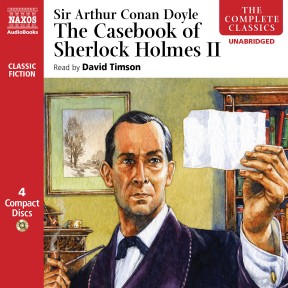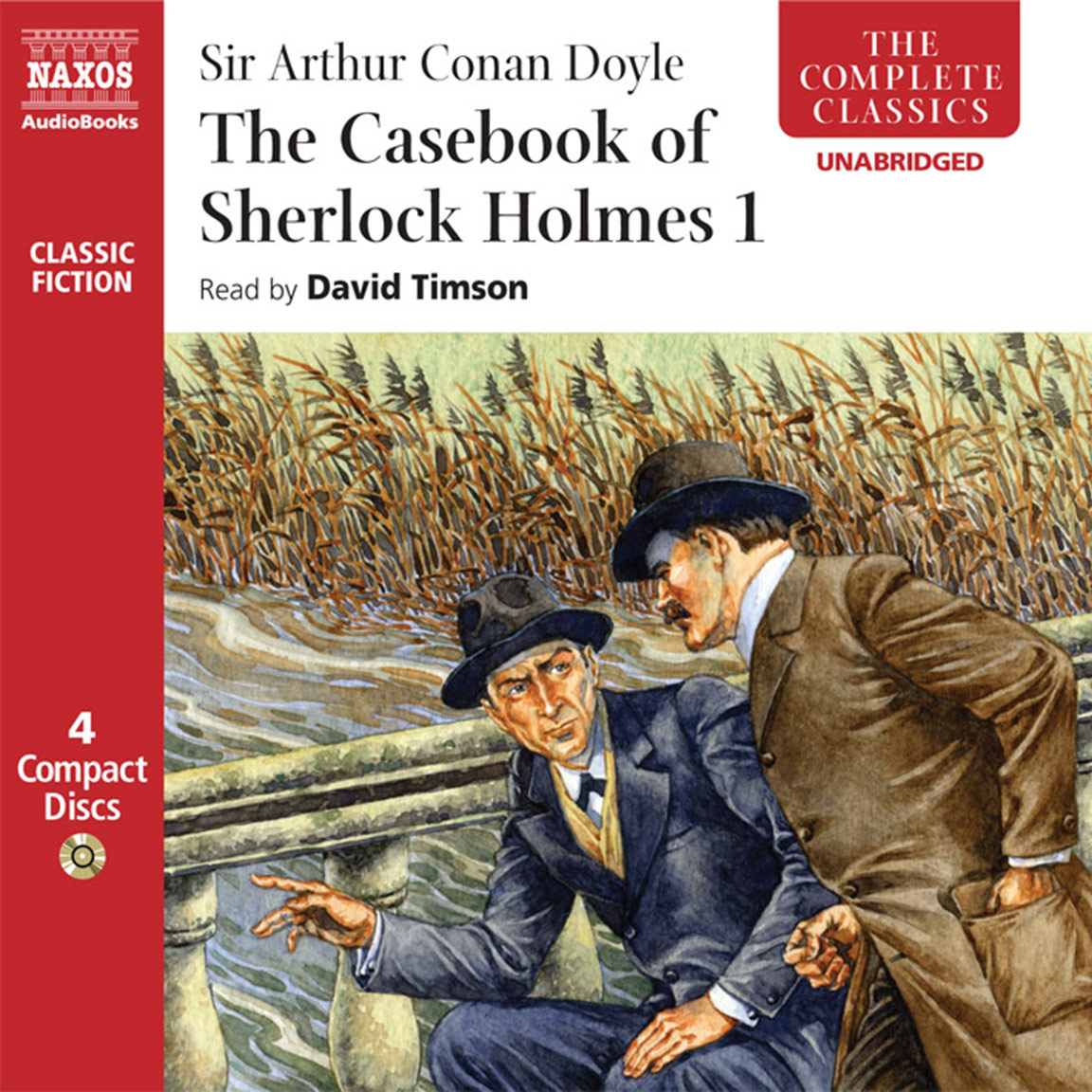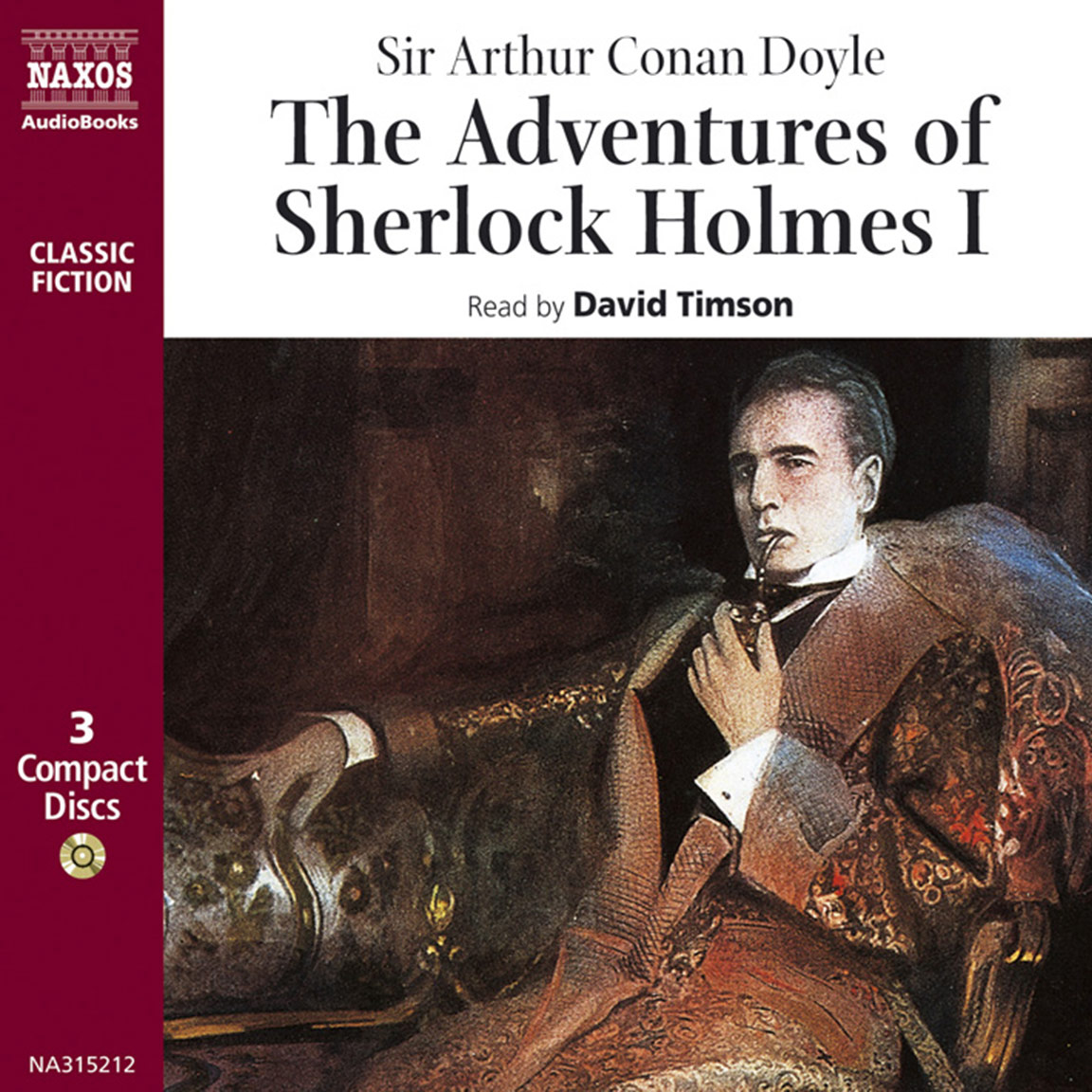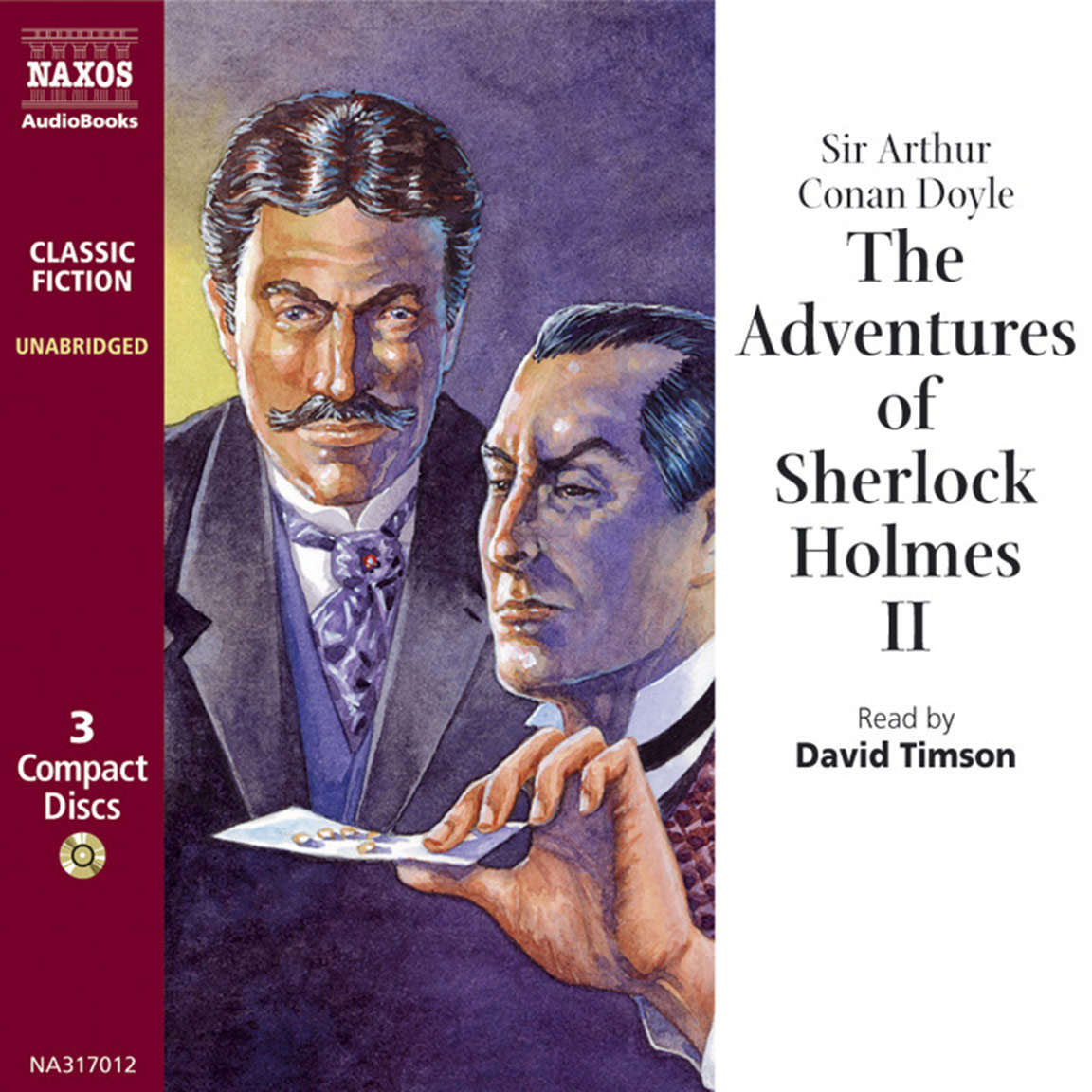
Audio Sample
Sir Arthur Conan Doyle
The Casebook of Sherlock Holmes – Volume II
The Veiled Lodger | The Illustrious Client | The Three Gables | The Retired Colourman | The Lion’s Mane | Shoscombe Old Place, Plus: The Wonderful Toy – written by David Timson
Read by David Timson
unabridged
In the last six stories written by Conan Doyle featuring Sherlock Holmes and Dr Watson, the duo face some of their most challenging cases. In The Adventure of the Illustrious Client, Holmes puts his own life in danger as he tries to cut short a young girl’s infatuation with the notorious wife-murderer Baron Gruner. Why is Mrs. Maberley offered a handsome price for the Three Gables, provided she leaves at once and takes nothing with her? Even in his retirement, Holmes’s skills are called upon, as he follows a trail of death on the Sussex coast in The Adventure of the Lion’s Mane.

-
4 CDs
Running Time: 5 h 18 m
More product details
ISBN: 978-962-634-862-8 Digital ISBN: 978-962-954-513-0 Cat. no.: NA486212 Download size: 77 MB BISAC: FIC004000 Released: March 2008 -
Listen to this title at Audible.com↗Buy on CD at Downpour.com↗Listen to this title at the Naxos Spoken Word Library↗
Due to copyright, this title is not currently available in your region.
You May Also Enjoy
Included in this title
- The Veiled Lodger
- The Illustrious Client
- The Three Gables
- The Retired Colourman
- The Lion’s Mane
- Shoscombe Old Place
- The Wonderful Toy
Reviews
Seven more truly ingenious criminal cases, only some of whose arch villains are the intellectual match of the legendary violin-playing, opium-smoking Baker Street sleuth, as he modestly observes to his long-suffering sidekick Dr Watson. Here’s one Baron Adelbert Gruner, “cool as ice, silky voiced, poisonous as a cobra with a superficial suggestion of afternoon tea, and all the cruelty of the grave behind it”. If Holmes’s insufferable conceitedness didn’t get under your skin (and David Timson portrays him brilliantly), you probably wouldn’t enjoy it as much.
Sue Arnold, The Guardian
Winner of AudioFile Earphones Award
With this package David Timson and Naxos complete their 10-year project to record the entire Holmes writings by Conan Doyle. Sherlockians regard The Casebook with mixed feelings, being the last and probably the least of Conan Doyle’s Holmes efforts. David Timson, however, excels in these respectful readings and more than compensates for the lesser material. He goes beyond voicing words clearly; he savors the language and gives attention to every phrase. The subtle use of music to mark setting changes is also effective. The collection concludes with a bonus story written and read by Timson (‘The Wonderful Toy’) on Holmes’s encounter with the new gramophone and, by implication, the birth of the audiobook era.
G.H., AudioFile
Booklet Notes
For the last decade-and-a-half of his life, Conan Doyle devoted himself heart and soul to the cause of spiritualism. He published more than twelve books on the subject, bemusing his readers, family and friends alike as to how the creator of such a rational fictional character as Sherlock Holmes could be deluded by this fake-science, and become the victim of charlatans and con-men.
In the year of his death, Conan Doyle gave an interview: ‘I am rather tired of hearing myself described as the author of “Sherlock Holmes”. Why not, for a change, the author of Rodney Stone or The White Company or The Lost World? One would think I had written nothing but detective stories.’ He had, by the end of his life, decided that his greater purpose was to preach the new religion of spiritualism; the writing of fiction was definitely the lesser calling. He was convinced that it was as a reformer and exponent of a great religion that he would be remembered by posterity.
‘I consider spiritualism to be infinitely the most important thing in the world, and the particular thing which the human race in its present state of development needs more than anything else.’
The editor of The Strand, Greenhough Smith, ever reluctant to accept that there would be no more cases for Sherlock Holmes to solve, persistently asked Conan Doyle: ‘More Holmes?’ In reply he would say: ‘I can only write what comes to me.’ What came to him was an endless flow of words, both written and spoken, that furthered the spiritualist cause. His obsession cost him a peerage, and lost him many friends who couldn’t square his belief with the man they thought they knew. When he publicly declared that he believed photographs of fairies, taken by two young girls in Cottingley, were genuine, many thought he had gone mad. The photographs were later proved fakes.
In Search for Truth by Harry Price, written in 1939, which contains a not uncritical account of Doyle’s attraction to spiritualism, Price wryly observes: ‘the spiritualists themselves have almost forgotten him, and have not even troubled to establish a memorial to his memory.’
Conan Doyle’s zeal for the spiritualist cause exhausted and eventually killed him. The stubbornness he could occasionally show increased when illness finally caught up with him in 1929, and against his doctor’s advice he continued to lecture and preach the doctrine of spiritualism without regard for his health.
In a moment of reflection on a crowded life, Conan Doyle drew a cartoon of an old work-horse struggling to pull a cart piled high with his life’s achievements. Under the sketch he wrote: ‘The old horse has pulled a heavy load a long way.’ He died in July 1930, no doubt faithful to his belief that death was merely a gateway to eternal life. He was buried in his Sussex garden. On the headstone over the grave was an epitaph representing his life’s creed: ‘Steel true, blade straight.’
THE ADVENTURE OF THE VEILED LODGER
The world of the nineteenth-century circus is recalled in this case, a form of entertainment much changed since its heyday in the era of Holmes and Watson, when animal acts and freak shows were commonplace. ‘Lord’ George Sanger became a millionaire from his circus, which was still in existence in the 1950s. Sanger was the first to introduce lions into the ring, and created the three-ring circus copied by P. T. Barnum. Wombwell’s Menagerie toured the kingdom, giving opportunities for people in remote parts of the country to see exotic animals at close quarters. Wombwell’s wife met the same fate as ‘Mrs. Ronder’, but did not survive.
Suicide was still a crime in 1896, the probable year of this case, and Holmes shows his own strong feelings about the subject when he feels that Mrs. Ronder might be contemplating taking her own life. ‘Your life is not your own’ he tells her. Holmes has never really shown any strong religious conviction throughout the canon, so his response here is unusual. In The Sign of Four, Holmes had recommended that Watson should read The Martyrdom of Man, which he described as one of the most remarkable works ever written. It is against orthodox Christian thinking and talks of the death of the soul and the impossibility of immortality. Such convictions may well have contributed to Holmes’s frequent bouts of depression and the attractions of the ‘7% solution’. Ten years later, however, we find that Holmes has had a conversion: ‘The ways of fate,’ he says in this case,‘are indeed hard to understand. If there is not some form of compensation hereafter, then the world is a cruel jest.’ It is one of many occasions in The Case-book where Conan Doyle shows Holmes’s increasingly philosophical nature.
Watson tells us that by the time of Holmes’s retirement in 1903, he had been 23 years in service, which, if one allows for the three years he disappeared after his supposed death at the Reichenbach falls, would give a date of 1877 as the beginning of Holmes’s career as a detective.
THE ADVENTURE OF THE ILLUSTRIOUS CLIENT
In The Sign of Four Holmes had declared: ‘Love is an emotional thing… opposed to that true, cold reason which I place above all things,’ and throughout the canon Holmes displays a disregard for, even an irritation with, the opposite sex, referring them to Watson as ‘your department’. Yet he was not a misogynist; he showed sympathy to many a young woman who came to Baker Street with a distressing problem to be solved, and on one notable occasion was almost conquered by one of them – Irene Adler in The Adventure of the Scandal in Bohemia. Holmes does, however, seem unusually taken with Violet de Merville; she gets under his skin. ‘She is beautiful,’ he tells Watson, ‘but with the ethereal other-world beauty of some fanatic whose thoughts are set on high…’. In his middle-age, she is an ideal for him, though he is aware of the age difference: ‘I thought of her… as I would have thought of a daughter of my own.’
Violet is one of a veritable bloom of Violets that blossom throughout the canon, and Conan Doyle, in this, one of his last stories, could not shake off the charm and significance the name obviously had for him. The first was the capable Miss Violet Hunter in The Adventure of the Copper Beeches; the others were the elegant Miss Smith who was The Solitary Cyclist, and the unhappy Miss Westbury in The Bruce-Partington Plans.
Who is the Illustrious, but anonymous, Client? Possibly the former Prince of Wales, now, in the year of this case – 1902 – newly crowned as King Edward VII.
He may have been involved in earlier cases too: The Adventure of the Beryl Coronet also has an anonymous client, and if he was the Lord Balmoral referred to in The Adventure of the Empty House, who had been gambling with the murdered Ronald Adair, he narrowly escaped being involved in a scandal himself. His motivation in this case seems obscure, apart from helping a pretty girl (which was probably motivation enough for King Edward).
Despite Damery covering the heraldic arms on the side of his coach with his overcoat, Watson is, with a mere glimpse, instantly able to recognise the client’s identity – another hint that it could indeed be the King himself.
Why is Watson living in Queen Anne Street? Is this evidence that Watson had married for a second time? He makes no mention of a wife, however, in this set of stories, and three months earlier in The Adventure of the Three Garridebs he was living in Baker Street. Some Sherlockian scholars have posed the idea that he had to move out and set up a practice once more to recover his gambling losses, which he refers to in a light-hearted way in The Adventure of Shoscombe Old Place (see notes). Also, with Holmes heading towards retirement, Watson may have had to look to his own financial future. We learn in The Adventure of the Creeping Man that Watson has a practice that is ‘not inconsiderable’, and a practice in Queen Anne Street, in the purlieus of Harley Street (the mecca of medical specialists), would indicate that by 1902 Watson was doing very well indeed. Good old Watson!
Is this case really the ‘supreme moment of my friend’s career’, as Watson describes it? There are surely ones that involved more deduction and skill, and others that had more at stake. In The Adventure of The Second Stain, for instance, the ruin of a cabinet minister and the possibility of war are averted by Holmes; whilst in The Bruce-Partington Plans he foils foreign attempts to discover Britain’s secret weapon, the submarine. In terms of reward, Holmes has had gifts from the King of Bohemia and Queen Victoria herself. Here he receives no gift, only an undisclosed fee from a grateful monarch. One hopes it was substantial enough to boost his income in retirement.
THE ADVENTURE OF THE THREE GABLES
Every fan of the Sherlock Holmes stories today must shudder at the naked display of racism by Holmes when talking to the Negro Steve Dixie. Was Conan Doyle striving in these last stories to destroy the idolatry that had developed around Holmes? It seems extreme to turn him into a racist, particularly when in The Yellow Face he had shown such sympathy for the young girl’s mixed-race origins. The truth is that this story is showing its age. Most Englishmen of the Victorian period, the age of Empire, would have responded to Steve Dixie in a similar way. The white British male’s belief in his superiority over the subdued races of the Empire was unquestioned. Holmes is a product of this prevailing 19th-century mood. If there is any mitigating circumstance, it is that Steve Dixie is an unpleasant and violent crook!
THE ADVENTURE OF THE RETIRED COLOURMAN
Who is Barker? Holmes refers to him as his ‘hated rival’, yet he is not mentioned in any other case. It is evident that by the date of this case, 1898, there were detectives who were adopting Holmes’s methods, and perhaps he no longer felt supreme in his field. Maybe that is why Holmes withdrew from the world of crime detection at such a comparatively early age.
The telephone features in this story, and had obviously been installed in Baker Street by this time. It quickly became an indispensable tool of Holmes’s trade, as important to him as the telegram was in earlier stories.
This late story shows the closeness and sensitivity that has developed between the two old friends. Holmes can of course still hurl a sarcastic comment Watson’s way: ‘Cut out the poetry, Watson!’; but he also exerts great care to give Watson his due. ‘You can thank Dr.Watson’s observation for that… Another of Dr. Watson’s bull’s-eyes…’.
There seems to be no actual singer of the period called ‘Carina’. This is strange, as Conan Doyle’s musical references are, with this exception, genuine. It has been suggested (by Mr. A. Boucher) that ‘Carina’ (which means ‘darling’ in Italian) is Holmes’s own pet-name for the singer, giving us a tantalising glimpse, however unlikely, into a possible love-affair which is never explored by the discreet Dr. Watson!
THE ADVENTURE OF THE LION’S MANE
Watson tells us that by the spring of 1897 ‘the constant hard work’ was beginning to tell upon Holmes’s iron constitution; six years later, after The Adventure of the Creeping Man, Holmes retired to a villa in Sussex, which provides the background to this case. Having survived his creator’s attempt to kill him off prematurely in The Adventure of the Final Problem, and given the erratic attitude that Conan Doyle continued to have towards his greatest creation, it is a wonder Holmes reached retirement unscathed.
One hopes that the old housekeeper who looks after him is the indomitable Mrs. Hudson!
Holmes in his retirement, however, is a changed man. He has convinced himself that he has always had a longing for a life by the sea, but in an earlier case (The Adventure of the Cardboard Box), Watson noted that ‘the country nor the sea presented the slightest attraction to him. He loved to lie in the very centre of five millions of people.’
Holmes seems now to have become a lover of nature, and, more surprisingly – as he used to experiment on them (see A Study in Scarlet) – dogs! Though he describes himself as slow in solving this case, Holmes seems to have lost none of his old incisive powers of deduction, nor his weakness for a dramatic denouement. Finally, albeit in his more mature years, he has developed an appreciation of beautiful women: Violet de Merville as noted in The Adventure of the Illustrious Client; and Miss Maud Bellamy here. ‘She would have graced any assembly in the world,’ says Holmes.
Withdrawing from a life crowded with incident, Holmes is content instead to be merely an observer of society – the society in question being the ordered world of bees. He focuses on them all his skills of analysis and deduction, which had so terrified the criminal fraternity. The result of his studies is The Practical Handbook of Bee Culture, with some observations upon the Segregation of the Queen. Holmes proudly calls it his magnum opus, though the world would probably have preferred the study of criminality that he once promised to write, which was to be called The Whole Art of Detection.
He may have escaped the bovine branch of the London police force, with whom he had to deal on so many occasions, but Sussex has its own breed in Inspector Bardle, whose observation that Holmes likes to do things thoroughly in an investigation prompts the acid reply: ‘I should hardly be what I am if I did not.’ Perhaps Holmes felt that his reputation was suffering because of the activities of a new breed of detective, such as Barker (The Adventure of the Retired Colourman), to whom he refers as his ‘hated rival’.
If Holmes retired in 1903 then he was not yet 50 years old, and at the height of his powers. His statement that he had always longed for a country lifestyle whilst working in the heart of London doesn’t quite ring true. He lived for his work, and referred to the countryside in The Adventure of the Copper Beeches as being the place where crime could be more easily committed! Why then such an early retirement? Was he now so wealthy that he could at last indulge his hitherto un-confessed passion for bees? Or was Holmes’s retirement a blind to conceal his feverish activity in the Secret Service? In the years between his retirement (in 1903) and 1914, the tension between England and Germany grew to alarming proportions, and Holmes’s sharp brain would have been invaluable to counter espionage, as war inevitably approached. His Last Bow deals with just such a scenario.
THE ADVENTURE OF SHOSCOMBE OLD PLACE
And so we come to the last Sherlock Holmes story Conan Doyle ever wrote. The last line is fitting as an unintentional tribute to Holmes in his retirement: ‘[A career which has] ended in an honoured old age.’
The duo, however, are in good form. Holmes displays his usual lack of respect for the idle rich: ‘Sir Robert is a man of an honourable stock. But you do occasionally find a carrion crow among the eagles’; while Watson amusingly tugs his forelock, metaphorically, at the monstrous supposition that a nobleman like Sir Robert could be a cad.
Even in 1902, the year before his retirement, Holmes is still pushing back scientific boundaries and experimenting with ‘a microscope’ – a new tool, he admits, for him, in the fight against crime – along with the aforementioned telephone.
Was Watson a heavy gambler? To admit to spending half his wound pension on betting does seem excessive – or is it merely a heavy-handed joke? Watson’s wound is variously described as being in the leg or the shoulder, so it is gratifying that the doctors were able to diagnose its exact location, making him eligible for a pension. If he was wounded twice, maybe the pension reflected this and gave him a comfortable income, or at least enough to be able to risk a flutter on the horses without too much financial inconvenience. Watson’s pension was 11s 6d a day in 1881, the year of A Study In Scarlet, which is about £200 a year. Holmes did, however, keep Watson’s cheque-book locked in a drawer during The Adventure of the Dancing Men. Was this to prevent him from gambling?
THE ADVENTURE OF THE WONDERFUL TOY
No, Sherlockians, this is not an undiscovered Conan Doyle manuscript, but a pastiche – with perhaps just a hint of parody. This collection of stories marks the end of a 10-year project to record the complete Sherlock Holmes stories for Naxos Audiobooks, and I felt I wanted to pay homage to Sir Arthur Conan Doyle, for whom (at least, as a writer of crime fiction) my admiration has grown with each succeeding year since I recorded the first selection of stories in 1997.
Conan Doyle wrote a preface to The Case-Book of Sherlock Holmes in which he wrote that he hoped there was a ‘fantastic limbo’ where fictional characters could continue their lives: ‘Perhaps in some humble corner of such a Valhalla, Sherlock and his Watson may for a time find a place, while some more astute sleuth with some even less astute comrade may fill the stage which they have vacated.’
The stage was filled: in the very year of the publication of The Case-Book (1927), Agatha Christie enjoyed her first success with The Murder of Roger Ackroyd, and the torch – carried (unwillingly, perhaps) by Conan Doyle for so long – passed on to a new talent whose prolific output would secure detective fiction as a successful genre forever.
David Timson




